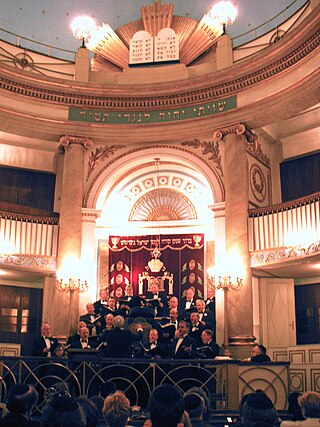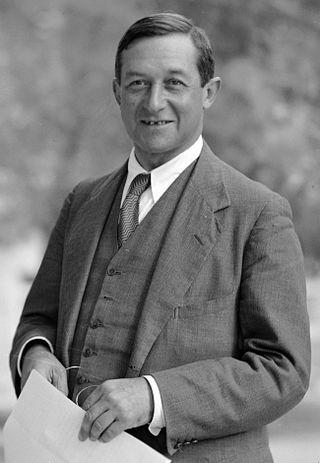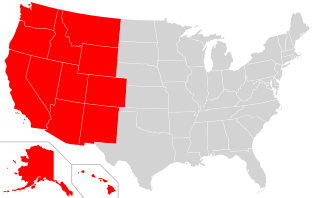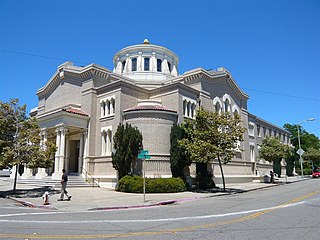
A hazzan or chazzan is a Jewish musician or precentor trained in the vocal arts who leads the congregation in songful prayer. In English, this prayer leader is often referred to as a cantor, a term also used in Christianity.

Congregation Emanu-El of New York is the first Reform Jewish congregation in New York City. It has served as a flagship congregation in the Reform branch of Judaism since its founding in 1845. The congregation uses Temple Emanu-El of New York, one of the largest synagogues in the world.

Judah Leon Magnes was a prominent Reform rabbi in both the United States and Mandatory Palestine. He is best remembered as a leader in the pacifist movement of the World War I period, his advocacy of a binational Jewish-Arab state in Palestine, and as one of the most widely recognized voices of 20th century American Reform Judaism. Magnes served as the first chancellor of the Hebrew University of Jerusalem (1925), and later as its President (1935–1948).

Temple Beth-El is a Reform Jewish synagogue located at 5 Old Mill Road in the village of Great Neck, Long Island, Nassau County, New York, in the United States. Founded in 1928, it is the oldest synagogue in Great Neck.

Rachel "Ray" Frank was a Jewish religious leader in the United States. Frank was an early figure in the acceptance of women rabbis and was reported as a prospective candidate for the first woman rabbi in the United States.

The 19th century saw Jews, like many other people, moving to the American West.

Temple Sinai is a Reform Jewish congregation and synagogue located at 2808 Summit Street in Oakland, California, in the United States. Founded in 1875, it is the oldest Jewish congregation in the East San Francisco Bay region.
Congregation Am Tikvah is a combined Conservative and Reform Jewish congregation and synagogue located at 625 Brotherhood Way in San Francisco, California, in the United States. The congregation was formed in 2021 as the result of the merger of the Conservative B'nai Emunah and the Reform Beth Israel Judea congregations, with the latter formed in 1969 through a merger of the Conservative Congregation Beth Israel and the Reform Temple Judea. The congregation is affiliated with both the Union for Reform Judaism and the United Synagogue of Conservative Judaism.
The Union Prayer Book was a Siddur published by the Central Conference of American Rabbis to serve the needs of the Reform Judaism movement in the United States.
The modern Reform Cantorate is seen as a result of developments that took place during the 19th century, largely in Europe. The process continued to evolve in America following the emigration of German Reform Jews towards the end of the century.
Ben Steinberg was a Canadian composer, conductor, organist, and music educator. A member of the Canadian League of Composers and an associate of the Canadian Music Centre, he is known for his contributions to Jewish music. He has presented many programs of Jewish music for the Canadian Broadcasting Corporation and has presented similar programs in lecture-recitals throughout Canada, the United States, Australia, and Japan. He has also contributed articles on Jewish music to a number of publications. Several of his original manuscripts and papers are held in the collection at the library of the University of Calgary.
Joseph Asher (1921–1990) was an American rabbi born in Germany, known for his advocacy of reconciliation between the Jews and the Germans in the post-Holocaust era, and for his support for the civil rights movement in the United States. He was senior rabbi at Congregation Emanu-El in San Francisco for 19 years.

Congregation Sherith Israel is a Reform Jewish congregation and synagogue, located in San Francisco, California, in the United States. Founded in 1851 during California’s Gold Rush period, it is one of the oldest synagogues in the United States. In more modern times, the congregation widely known for its innovative approach to worship and lifecycle celebrations. Listed on the National Register of Historic Places, its historic sanctuary building, completed in 1905, is one of San Francisco's most prominent architectural landmarks.

Fred Rosenbaum is an American author, historian and adult educator, specializing in the history of the Jewish community of the San Francisco Bay Area. Rosenbaum has been called a "superb storyteller". He is a founder and the director of Lehrhaus Judaica in Berkeley, California, described as "the largest Jewish adult education center in the western United States".

Julie Eichberg Rosewald was an American opera singer. She is considered the first female cantor in the United States, serving San Francisco's Temple Emanu-El from 1884 until 1893.

Louis Israel Newman, was an American Reform rabbi, and author. While working in New York City, Newman later became a member of the Zionist Revisionist movement. He worked as a rabbi in San Francisco, Berkeley, New York City, and Waltham, Massachusetts. Newman was known for his progressive views, his involvement in the Zionist Revisionist movement, and his prolific writing, which included books on Jewish history, theology, and identity.
Lazarus Dinkelspiel (1824–1900) was an American businessman who founded L. Dinkelspiel & Co.
Aaron Fleishhacker was a Kingdom of Bavaria-born American businessman who founded paper box manufacturer, A. Fleishhacker & Co. He had been active during the Gold Rush with the formation of Comstock silver mines.

The history of the Jews in San Francisco began with the California Gold Rush in the second half of the 19th-century.
Martin Abraham Meyer was an American rabbi.
















